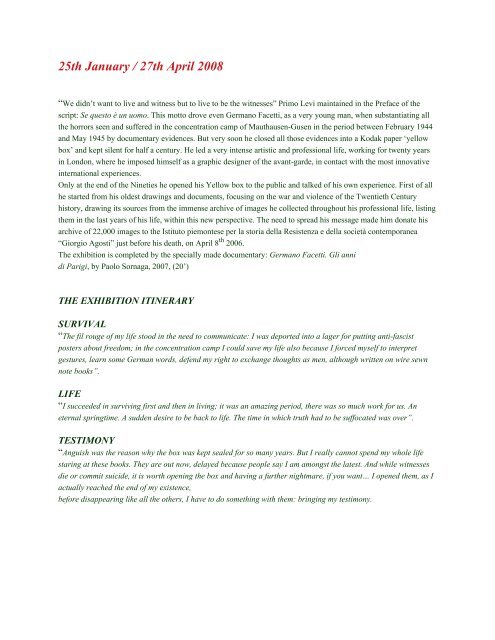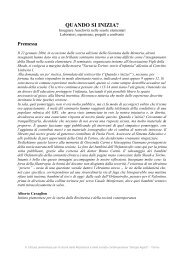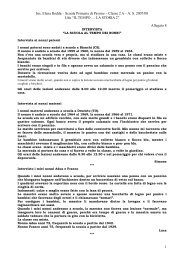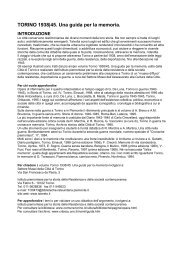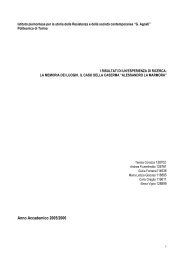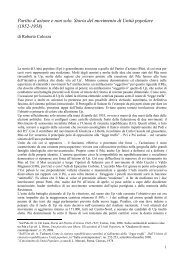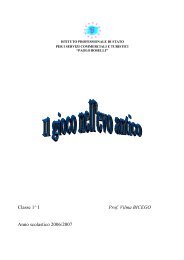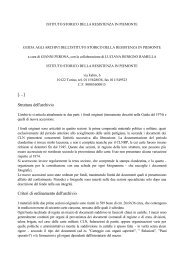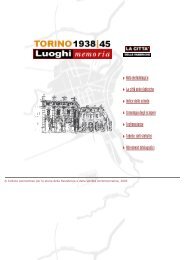"(R)esistere per immagini " - Germano Facetti from the Lager ...
"(R)esistere per immagini " - Germano Facetti from the Lager ...
"(R)esistere per immagini " - Germano Facetti from the Lager ...
You also want an ePaper? Increase the reach of your titles
YUMPU automatically turns print PDFs into web optimized ePapers that Google loves.
25th January / 27th April 2008<br />
“We didn’t want to live and witness but to live to be <strong>the</strong> witnesses” Primo Levi maintained in <strong>the</strong> Preface of <strong>the</strong><br />
script: Se questo è un uomo. This motto drove even <strong>Germano</strong> <strong>Facetti</strong>, as a very young man, when substantiating all<br />
<strong>the</strong> horrors seen and suffered in <strong>the</strong> concentration camp of Mauthausen-Gusen in <strong>the</strong> <strong>per</strong>iod between February 1944<br />
and May 1945 by documentary evidences. But very soon he closed all those evidences into a Kodak pa<strong>per</strong> ‘yellow<br />
box’ and kept silent for half a century. He led a very intense artistic and professional life, working for twenty years<br />
in London, where he imposed himself as a graphic designer of <strong>the</strong> avant-garde, in contact with <strong>the</strong> most innovative<br />
international ex<strong>per</strong>iences.<br />
Only at <strong>the</strong> end of <strong>the</strong> Nineties he opened his Yellow box to <strong>the</strong> public and talked of his own ex<strong>per</strong>ience. First of all<br />
he started <strong>from</strong> his oldest drawings and documents, focusing on <strong>the</strong> war and violence of <strong>the</strong> Twentieth Century<br />
history, drawing its sources <strong>from</strong> <strong>the</strong> immense archive of images he collected throughout his professional life, listing<br />
<strong>the</strong>m in <strong>the</strong> last years of his life, within this new <strong>per</strong>spective. The need to spread his message made him donate his<br />
archive of 22,000 images to <strong>the</strong> Istituto piemontese <strong>per</strong> la storia della Resistenza e della società contemporanea<br />
“Giorgio Agosti” just before his death, on April 8 th 2006.<br />
The exhibition is completed by <strong>the</strong> specially made documentary: <strong>Germano</strong> <strong>Facetti</strong>. Gli anni<br />
di Parigi, by Paolo Sornaga, 2007, (20’)<br />
THE EXHIBITION ITINERARY<br />
SURVIVAL<br />
“The fil rouge of my life stood in <strong>the</strong> need to communicate: I was deported into a lager for putting anti-fascist<br />
posters about freedom; in <strong>the</strong> concentration camp I could save my life also because I forced myself to interpret<br />
gestures, learn some German words, defend my right to exchange thoughts as men, although written on wire sewn<br />
note books”.<br />
LIFE<br />
“I succeeded in surviving first and <strong>the</strong>n in living; it was an amazing <strong>per</strong>iod, <strong>the</strong>re was so much work for us. An<br />
eternal springtime. A sudden desire to be back to life. The time in which truth had to be suffocated was over”.<br />
TESTIMONY<br />
“Anguish was <strong>the</strong> reason why <strong>the</strong> box was kept sealed for so many years. But I really cannot spend my whole life<br />
staring at <strong>the</strong>se books. They are out now, delayed because people say I am amongst <strong>the</strong> latest. And while witnesses<br />
die or commit suicide, it is worth opening <strong>the</strong> box and having a fur<strong>the</strong>r nightmare, if you want… I opened <strong>the</strong>m, as I<br />
actually reached <strong>the</strong> end of my existence,<br />
before disappearing like all <strong>the</strong> o<strong>the</strong>rs, I have to do something with <strong>the</strong>m: bringing my testimony.


